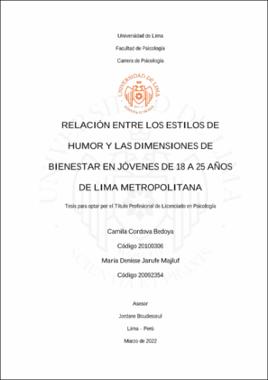Relación entre los estilos de humor y las dimensiones de bienestar en jóvenes de 18 a 25 años de Lima Metropolitana

Ver/
Cordova_Jarufe_Relación-entre-estilos-humor-dimensiones-bienestar.pdf
(application/pdf: 813.4Kb)
(application/pdf: 813.4Kb)
Fecha
2022Asesor(es)
Metadatos
Mostrar el registro completo del ítemResumen
Esta investigación describe la relación entre bienestar y estilos de humor en adultos emergentes (18-25 años) de Lima Metropolitana. La muestra, obtenida por bola de nieve, estuvo compuesta por 108 participantes (M = 21.56, D.E. = 2.71, 58.3% mujeres). Se utilizaron las Escalas de Florecimiento y Afectividad propuestas por Diener et al. (2010) y la Escala sobre el Sentido del Humor (HSQ) de Martin et al. (2003) ambas adaptadas por Cassaretto y Martínez en 2017 y 2009 respectivamente. Se encontró que sí existe relación entre el bienestar y los estilos de humor. A continuación, los hallazgos: el humor afiliativo correlaciona positivamente con el afecto positivo (r = .30, p < 0.01) y florecimiento (r = .27, p < 0.01); sin embargo, correlaciona negativamente con el afecto negativo (r = -.16, p > 0.05). El humor reafirmante, correlaciona positivamente con el afecto positivo (r = .23, p < 0.05) y florecimiento (r = .10, p > 0.05), no obstante, tiene una correlación negativa con el afecto negativo (r = -.23, p < 0.05). El humor agresivo, correlaciona negativamente con el afecto positivo (r = -.45, p < 0.01) y florecimiento (r= -.34, p < 0.01), mientras que, correlaciona positivamente con el afecto negativo (r = .11, p > 0.05). El humor descalificativo, correlaciona negativamente con el afecto positivo (r = -.18, p > 0.05) y florecimiento (r = -.26, p < 0.01), y positivamente con el afecto negativo (r = .24, p < 0.05). This study aimed to describe the correlation between well-being and different types of humor in emerging adults (18-25 years old) from Lima Metropolitana. The sample, selected based on the snowball method, was composed of 108 participants aged between (M = 21.56, S.D. = 2.71, 58.3% were female). The instruments used in conducting the experiment consisted of the Scale of Positive and Negative Experience and Flourishing Scale, proposed by Diener et al. (2010), yielding to the Peruvian reality by Cassaretto and Martínez (2017), and the Humor Styles Questionnaire (HSQ) by Martin et. al. (2003), yielding to the Peruvian reality by Cassaretto and Martínez (2009). A relationship between well-being and humor styles was found. Findings are briefly mentioned below: Affiliative humor was found to positively correlate with positive affect (r = .30, p < 0.01) and flourishing (r = .27, p < 0.01), however, it negatively correlates with negative affect (r = -. 16, p > 0.05). Self-enhancing humor, positively correlates with positive affect (r = .23, p < 0.05) and flourishing (r = .10, p > 0.05), however, it has a negative correlation with negative affect (r = -. 23, p < 0.05). Aggressive humor, negatively correlates with positive affect (r = -.45, p < 0.01) and flourishing (r = -.34, p < 0.01), while it positively correlates with negative affect (r = .11, p > 0.05). Self-defeating humor correlates negatively with positive affect (r = -.18, p > 0.05) and flourishing (r = -.26, p < 0.01), and positively with negative affect (r = .24, p < 0.05).
Cómo citar
Cordova Bedoya, C. y Jarufe Majluf, M. D. (2022) Relación entre los estilos de humor y las dimensiones de bienestar en jóvenes de 18 a 25 años de Lima Metropolitana [Tesis para optar el Título Profesional de Licenciado en Psicología, Universidad de Lima]. Repositorio institucional de la Universidad de Lima. https://hdl.handle.net/20.500.12724/15774Editor
Universidad de LimaTemas
Coleccion(es)
- Tesis [162]
El ítem tiene asociados los siguientes ficheros de licencia:

